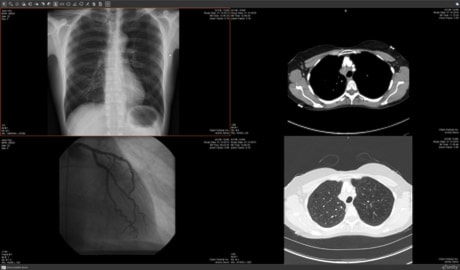A doctor sits down with a hospital patient to review test results but instead of fumbling with the usual clipboard or file of papers, she reaches into her lab coat and pulls out a tablet computer.
With a few taps and finger swipes, X-rays are pulled up. The doctor pinches to zoom in and out of the high-resolution image, then pulls up a CT scan and explains what’s happening.
Later, the patient can load the same digital files onto their own tablet, computer or smartphone.
This scene could be mere months away at Toronto’s Sunnybrook Health Sciences Centre.
The teaching hospital has partnered with Client Outlook Inc., based in Waterloo, Ont., to roll out digital imaging software called eUnity. It’s a Flash-based program that works inside a web browser and does the job of a $20,000 workstation.
Typically, clinicians in a hospital would have to use a picture archiving and communication system, known as PACS machines in the industry, to pull up digital test results. Problem is, they’re extremely expensive, which limits how many hospitals can realistically deploy throughout their buildings.
Now, eUnity means hospital staff can do the same work using a web browser on standard desktop computers. And, because it’s a web application, there’s no software to install on each computer, a major bonus for IT staff.
In September, eUnity was approved by Health Canada as a diagnostic tool. Soon after, Sunnybrook began testing it.
The hospital had been waiting years for something like eUnity to come along, said Andrew Volkening, Sunnybrook’s PACS administrator.
“Not only is it something we don’t have to install software (for) anywhere, but it’s delivering those high-resolution images at an almost real-time speed — and that’s not an easy thing, technically, to do, I know,” Volkening said.
The hospital conducts about 300,000 examinations a year and creates as many as 18 million digital images for test results. Sunnybrook only has about 250 PACS machines, including some in underutilized areas like operating rooms, and others that are so busy lines sometimes form to use them, Volkening said.
“You spend quite a bit of time at a workstation. . . . Our average CT now is over 600 images, which is much larger than what it used to be, and when you’re going through a CT image it’s time consuming. It can take you 20 minutes and someone else might be waiting behind you,” he said.
“Something like eUnity would let (doctors) pull it up on the computers they already have in the O.R. and I don’t have to give them a specialized workstation.”
Although eUnity is still in the testing phase and hasn’t been fully rolled out, Volkening said early reviews have been enthusiastic and those who have access to the software are envied by other staff.
“The feedback’s been extremely positive, everybody is emailing now saying, ’When is everyone going to get the software?’ because it’s something that’s been a long time coming.”
The technology is exciting for hospital professionals but a recent demo of eUnity on a tablet also created buzz outside the health-care sector.
Last week, eUnity had the distinction of sharing the spotlight with Research In Motion (TSX:RIM) when the new PlayBook tablet — due for release next year — had its first live demonstration at a developers’ conference organized by tech company Adobe.
RIM chose eUnity as the first app to be run in public on the much-anticipated PlayBook.
“This application is really, really cool,” enthused Adobe CTO Kevin Lynch as he showcased eUnity to the crowd.
Client Outlook has more work to do to get the app version of eUnity approved for hospital use, but Volkening predicted it won’t be long before mobile devices are deployed.
“I think that’s going to end up sooner than later,” he said.
“Those types of devices really give a doctor mobility — they’re light to carry around — so I can see as more devices come out like the PlayBook, doctors will start asking for support for that and want to carry those around. I can really see 2011 having a demand for those types of devices.”
Volkening also said eUnity’s full implementation may lead to patients getting digital copies of their test results to review any time.
“One of the things we strongly believe in at Sunnybrook is giving patients access to their data, it’s something we do every day, we release information on discs to the patients,” he said.
“We believe strongly that patients have access to their data.”
Client Outlook’s CEO, Steve Rankin, said members of the eUnity team previously worked at health-care companies and did consulting work at hospitals, which helped them understand the need for the new software.
“It’s really just about making it easy to view medical images and the result can be tremendous,” Rankin said.
He’s now frequently in and out of Sunnybrook helping to get eUnity fully implemented.
He said the company is already “far along the process” in talking with more than 20 other Canadian hospitals about eUnity. They’re also moving toward FDA approval in the United States and have feelers out with American hospitals.
